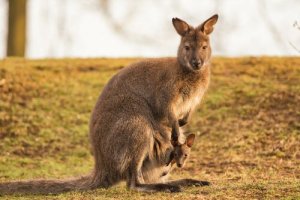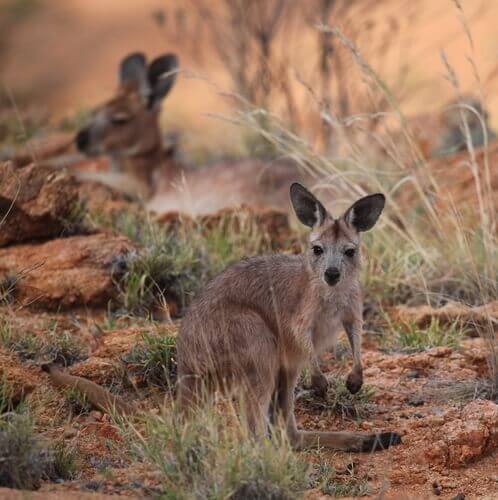The Common Wallaroo: Characteristics and Conservation


Written and verified by the biotechnologist Alejandro Rodríguez
The Australian continent is well-known for its marsupials, among other things. Out of all of them, perhaps the animal we are about to discuss in this article is one of the most notorious and representative of that continent. We’re talking about the common wallaroo. So, keep on reading if its name doesn’t ring a bell and you want to find out more.
What kind of animal is a common wallaroo?
As you may already know by looking at the images here, the common wallaroo is a type of kangaroo, and is perhaps the most common of all. The species belongs to a rather special infraclass of animals: the marsupials.
The most distinctive feature of all the marsupials is the presence of the epidermal bag that surrounds the mammary glands of a female kangaroo. This is where her offspring complete their development (the marsupium).
Within the marsupial category, kangaroos are members of the Macropodidae family. In addition, the characteristics of this group of mammals include a strictly herbivorous diet and their peculiar jumping method of moving around.
With regard to euro wallaroo or hill wallaroo, one can say they’re a marsupial mammal of the Macropodidae family. Their scientific name is Macropus robustus; the Macropus genus is broad and includes up to 14 different species.
General characteristics

This is one of those animal species that show sexual dimorphism. That means there are physiological differences between males and females. The latter are usually smaller.
The hind legs, which they use for moving, are short and wide, and highly developed. Also, their hind limbs finish in hands that point forward. Their hairless snout has a large, black nasal pad.
The Macropus robustus is an animal of nocturnal habits. When the stifling heat of the arid plains where they live is at its peak, these marsupials prefer to seek a shady spot to rest. When the sun goes down they mainly look for pastures to feed on.
Reproduction and conservation of the common wallaroo

A curious fact regarding the common wallaroo is that there’s no mating season as such. This is because females can gestate and give birth at any given time. That is, as long as the marsupial bag is not already in use by another young one!
In order to earn the right to mate, males engage in fighting. The fight is over when one of them gives up and retreats. Thus, a male of this species can mate with several females.
The gestation period of the common wallaroo lasts between 30 and 38 days. After which the offspring will transfer into the marsupium. There they’ll spend the next six months. From then on, they’ll also start spending most of their time on the ground.
The males of this species reach maturity between the 18 and 20 months of age. Similarly, females become adults from 14 to 24-months old.
Due to their high population and extensive habitat, the common wallaroo is not under threat when it comes to their conservation status. The IUCN catalogs them as of “minor concern.” Unfortunately, some subspecies of the Macropus genus who live on the islands are beginning to disappear.
Thanks for reading, why not go back to our main page for more wonderful facts about our animals?
The Australian continent is well-known for its marsupials, among other things. Out of all of them, perhaps the animal we are about to discuss in this article is one of the most notorious and representative of that continent. We’re talking about the common wallaroo. So, keep on reading if its name doesn’t ring a bell and you want to find out more.
What kind of animal is a common wallaroo?
As you may already know by looking at the images here, the common wallaroo is a type of kangaroo, and is perhaps the most common of all. The species belongs to a rather special infraclass of animals: the marsupials.
The most distinctive feature of all the marsupials is the presence of the epidermal bag that surrounds the mammary glands of a female kangaroo. This is where her offspring complete their development (the marsupium).
Within the marsupial category, kangaroos are members of the Macropodidae family. In addition, the characteristics of this group of mammals include a strictly herbivorous diet and their peculiar jumping method of moving around.
With regard to euro wallaroo or hill wallaroo, one can say they’re a marsupial mammal of the Macropodidae family. Their scientific name is Macropus robustus; the Macropus genus is broad and includes up to 14 different species.
General characteristics

This is one of those animal species that show sexual dimorphism. That means there are physiological differences between males and females. The latter are usually smaller.
The hind legs, which they use for moving, are short and wide, and highly developed. Also, their hind limbs finish in hands that point forward. Their hairless snout has a large, black nasal pad.
The Macropus robustus is an animal of nocturnal habits. When the stifling heat of the arid plains where they live is at its peak, these marsupials prefer to seek a shady spot to rest. When the sun goes down they mainly look for pastures to feed on.
Reproduction and conservation of the common wallaroo

A curious fact regarding the common wallaroo is that there’s no mating season as such. This is because females can gestate and give birth at any given time. That is, as long as the marsupial bag is not already in use by another young one!
In order to earn the right to mate, males engage in fighting. The fight is over when one of them gives up and retreats. Thus, a male of this species can mate with several females.
The gestation period of the common wallaroo lasts between 30 and 38 days. After which the offspring will transfer into the marsupium. There they’ll spend the next six months. From then on, they’ll also start spending most of their time on the ground.
The males of this species reach maturity between the 18 and 20 months of age. Similarly, females become adults from 14 to 24-months old.
Due to their high population and extensive habitat, the common wallaroo is not under threat when it comes to their conservation status. The IUCN catalogs them as of “minor concern.” Unfortunately, some subspecies of the Macropus genus who live on the islands are beginning to disappear.
Thanks for reading, why not go back to our main page for more wonderful facts about our animals?
All cited sources were thoroughly reviewed by our team to ensure their quality, reliability, currency, and validity. The bibliography of this article was considered reliable and of academic or scientific accuracy.
- King, J. M., & Bradshaw, S. D. (2010). Stress in an island kangaroo? The Barrow Island euro, Macropus robustus isabellinus. General and comparative endocrinology, 167(1), 60-67.
- Janke, A., Xu, X., & Arnason, U. (1997). The complete mitochondrial genome of the wallaroo (Macropus robustus) and the phylogenetic relationship among Monotremata, Marsupialia, and Eutheria. Proceedings of the National Academy of Sciences, 94(4), 1276-1281.
This text is provided for informational purposes only and does not replace consultation with a professional. If in doubt, consult your specialist.








